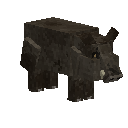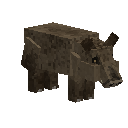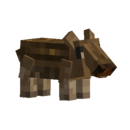Bighorn sheep: Difference between revisions
No edit summary |
No edit summary |
||
| Line 1: | Line 1: | ||
<languages /> | <languages/><translate> | ||
</translate> | |||
{{AnimalTabs | {{AnimalTabs | ||
|Name=<translate><!--T: | |Name=<translate><!--T:9--> Wild Pigs</translate> | ||
|Title= <translate><!--T: | |Title= <translate><!--T:10--> Boar</translate> | ||
|Title2= <translate><!--T: | |Title2= <translate><!--T:11--> Sow</translate> | ||
|Title3= <translate><!--T: | |Title3= <translate><!--T:12--> Piglet</translate> | ||
|image= File: | |image= File:Wild pig(Male).png | ||
|image2 = File: | |image2 = File:Wild pig(Female).png | ||
|image3 = File: | |image3 = File:Wild pig(Baby).png | ||
| | |HealthMF= 15 | ||
|HealthB= 7 | |||
|HealthB= | |BaseAttackM=5 | ||
|BaseAttackM= | |BaseAttackF=4 | ||
|BaseAttackF= | |||
|BaseAttackB=0 | |BaseAttackB=0 | ||
|PortionsEaten=10 | |PortionsEaten=10 | ||
|GestationTime= | |GestationTime=25 | ||
|GrowthTime= | |GrowthTime= 6.5 | ||
|DropCode1={{ll|Redmeat|<translate><!--T: | |DropCode1={{ll|Redmeat|<translate><!--T:13--> Redmeat</translate>}} | ||
|DropAvg1= | |DropAvg1=9 | ||
|DropVar1= | |DropVar1=1.5 | ||
|DropCode2={{ll|Raw hide|<translate><!--T: | |DropCode2={{ll|Raw hide|<translate><!--T:14--> Raw Hide (Medium)</translate>}} | ||
|DropAvg2=1. | |DropAvg2=1.5 | ||
|DropCode3={{ll|Fat|<translate><!--T:15--> Fat</translate>}} | |||
|DropCode3={{ll|Fat|<translate><!--T: | |DropAvg3=2 | ||
|DropAvg3= | |DropCode4={{ll|Bone|<translate><!--T:16--> Bone</translate>}} | ||
|DropAvg4=3.4 | |||
|DropCode4={{ll|Bone|<translate><!--T: | |DropVar4=0.5 | ||
|DropAvg4=5 | |||
|FloatRight=yes | |FloatRight=yes | ||
|NoBreak=yes | |NoBreak=yes | ||
| Line 34: | Line 33: | ||
<translate> | <translate> | ||
<!--T: | <!--T:7--> | ||
''' | <big>'''''A temperamental beast.'''''</big> | ||
<!--T:17--> | |||
'''Wild pigs''' are one of the common animals found in the world, and are a source of red meat, hide, fat, and bones. | |||
</translate> | </translate> | ||
| Line 41: | Line 43: | ||
<translate> | <translate> | ||
== Spawning == <!--T: | == Spawning == <!--T:1--> | ||
<!--T: | <!--T:18--> | ||
Wild pigs will spawn in light levels 10 and higher, at temperatures between -10 and 28, in areas with as little as 0.45 rainfall. They spawn in groups with an average of around 3 animals. | |||
== | == Behavior == <!--T:2--> | ||
<!--T:19--> | |||
As with other animals, the piglets tend to stay close to the sows and the sows tend to stay around the males. The males will lay down and ignore the player unless provoked, either by hitting or getting too close to them. Sows are just as likely to attack as to ignore players, while the piglets will just resort to flee on approach. In spite of this, all boars flee from the player if their health gets low. | |||
== | == Domestication and Breeding == <!--T:3--> | ||
<!--T: | <!--T:20--> | ||
After being rounded up in a pen, | After being rounded up in a pen, boars can be fed using a large trough which can hold 8 portions of food. Sows will need to eat at least 10 portions before they’re ready to mate, which after 600 hours (25 in game days) will bear a litter of 4 to 6 piglets (with a 25% chance of being males and a 75% chance of being females). This is important to consider when breeding multiple females simultaneously. After giving birth, sows will have a cooldown period before they can breed again, which can last from 6 to 11 days. Once the piglets are born, it takes 158 hours (5 in game days) for them to become full adults. Boars will become passive to the player and piglets will lose their fear after 10 generations. From the 3rd generation, the player can instantly kill boars with a {{ll|Cleaver|cleaver}}. | ||
=== Food === <!--T: | === Food === <!--T:22--> | ||
<!--T: | <!--T:23--> | ||
Food that can be placed in the large trough to feed the | Food that can be placed in the large trough to feed the Wild pigs: | ||
</translate> | </translate> | ||
{|class="wikitable" | {|class="wikitable" | ||
|- | |- | ||
! <translate><!--T: | ! <translate><!--T:27--> Image</translate> !! <translate><!--T:28--> Food for Wild pigs</translate> | ||
|- | |- | ||
| [[File:Grid_Dry_Grass.png|32px]] || <translate><!--T: | | [[File:Grid_Dry_Grass.png|32px]] || <translate><!--T:29--> Dry grass</translate> | ||
|- | |- | ||
| [[File:Grid_spelt.png|32px]] || <translate><!--T: | | [[File:Grid_spelt.png|32px]] || <translate><!--T:30--> Spelt</translate> | ||
|- | |- | ||
| [[File:Grain-rye.png|32px]] || <translate><!--T: | | [[File:Grain-rye.png|32px]] || <translate><!--T:31--> Rye</translate> | ||
|- | |- | ||
| [[File:Grid_Flax_grain.png|32px]] || <translate><!--T: | | [[File:Grid_Flax_grain.png|32px]] || <translate><!--T:32--> Flax</translate> | ||
|- | |- | ||
| [[File:Grain-amaranth.png|32px]] || <translate><!--T: | | [[File:Grain-amaranth.png|32px]] || <translate><!--T:33--> Amaranth</translate> | ||
|- | |- | ||
| [[File:Grain-sunflower.png|32px]] || <translate><!--T: | | [[File:Grain-sunflower.png|32px]] || <translate><!--T:34--> Sunflower</translate> | ||
|- | |- | ||
| [[File: | | [[File:Cassava.png|32px]] || <translate><!--T:35--> Cassava</translate> | ||
|- | |- | ||
| [[File: | | [[File:Legume-soybean.png|32px]] || <translate><!--T:36--> Soybean</translate> | ||
|- | |- | ||
| [[File: | | [[File:Legume-peanut.png|32px]] || <translate><!--T:37--> Peanut</translate> | ||
|- | |- | ||
| [[File: | | [[File:Vegetable-turnip.png|32px]] || <translate><!--T:38--> Turnip</translate> | ||
|- | |- | ||
| [[File: | | [[File:Carrot.png|32px]] || <translate><!--T:39--> Carrot</translate> | ||
|- | |- | ||
| [[File: | | [[File:Grid_onion.png|32px]] || <translate><!--T:40--> Onion</translate> | ||
</translate> | |||
|- | |- | ||
| [[File:Vegetable-cabbage.png|32px]] || <translate><!--T:41--> Cabbage</translate> | |||
|- | |- | ||
| | | [[File:Pumpkin-fruit-4.png|32px]] || <translate><!--T:42--> Pumpkin</translate> | ||
|- | |- | ||
| | | [[File:Pressedmash-cranberry.png|32px]] || <translate><!--T:43--> Dry fruit mash</translate> | ||
|- | |||
|} | |} | ||
<translate> | <translate> | ||
<!--T: | ===Petting=== <!--T:25--> | ||
<!--T: | <!--T:26--> | ||
You can {{Using|pet}} wild pigs when they are generation 1 or higher. Petting causes the animal to stand peacefully. | |||
<!--T: | == Drops == <!--T:4--> | ||
<!--T:21--> | |||
{{SneakClick|Butcher}} the animal by right-clicking while crouching with a {{ll|Knife|knife}} in the active hand to harvest its corpse. | {{SneakClick|Butcher}} the animal by right-clicking while crouching with a {{ll|Knife|knife}} in the active hand to harvest its corpse. | ||
<!--T: | <!--T:5--> | ||
'''An adult | '''An adult boar and sow drops:'''<br /> | ||
* | * 8-11 raw redmeat | ||
* 1-2 raw hide ( | * 1-2 raw hide (medium) | ||
* | * 2 fat | ||
* | * 3-4 bones | ||
'''A piglet drops:''' <br /> | |||
* 0-1 raw redmeat | |||
''' | |||
* | |||
</translate> | </translate> | ||
{{Entities navbox}} | {{Entities navbox}} | ||
{{Game navbox}} | {{Game navbox}} | ||
[[Category:Creatures{{#translation:}}]] | [[Category:Creatures{{#translation:}}]] | ||
[[Category:Domesticated animals{{#translation:}}]] | |||
[[Category:Animals{{#translation:}}]] | [[Category:Animals{{#translation:}}]] | ||
Revision as of 06:05, 5 August 2023
| Wild Pigs | |
| Health | |
| Health (Boar/Sow) | 15 |
| Health (Piglet) | 7 |
| Attack | |
| Base Attack (Boar) | 5 |
| Base Attack (Sow) | 4 |
| Base Attack (Piglet) | 0 |
| Behavior | |
| Multiply | |
| Satiety to Mate (portions) | 10 |
| Gestation Time (days) | 25 |
| Growth Time (days) | 6.5 |
| Drops | |
| Redmeat | 7.5 - 10.5* |
| Raw Hide (Medium) | 1.5* |
| Fat | 2* |
| Bone | 2.9 - 3.9* |
| Bone | 2.9 - 3.9* |
| Bone | 2.9 - 3.9* |
| Animals | |
A temperamental beast.
Wild pigs are one of the common animals found in the world, and are a source of red meat, hide, fat, and bones.
Spawning
Wild pigs will spawn in light levels 10 and higher, at temperatures between -10 and 28, in areas with as little as 0.45 rainfall. They spawn in groups with an average of around 3 animals.
Behavior
As with other animals, the piglets tend to stay close to the sows and the sows tend to stay around the males. The males will lay down and ignore the player unless provoked, either by hitting or getting too close to them. Sows are just as likely to attack as to ignore players, while the piglets will just resort to flee on approach. In spite of this, all boars flee from the player if their health gets low.
Domestication and Breeding
After being rounded up in a pen, boars can be fed using a large trough which can hold 8 portions of food. Sows will need to eat at least 10 portions before they’re ready to mate, which after 600 hours (25 in game days) will bear a litter of 4 to 6 piglets (with a 25% chance of being males and a 75% chance of being females). This is important to consider when breeding multiple females simultaneously. After giving birth, sows will have a cooldown period before they can breed again, which can last from 6 to 11 days. Once the piglets are born, it takes 158 hours (5 in game days) for them to become full adults. Boars will become passive to the player and piglets will lose their fear after 10 generations. From the 3rd generation, the player can instantly kill boars with a cleaver.
Food
Food that can be placed in the large trough to feed the Wild pigs:
| Image | Food for Wild pigs |
|---|---|
| Dry grass | |
| Spelt | |
| Rye | |
| Flax | |
| Amaranth | |
| Sunflower | |
| Cassava | |
| Soybean | |
| Peanut | |
| Turnip | |
| Carrot | |
| Onion | |
| Cabbage | |
| Pumpkin | |
| Dry fruit mash |
Petting
You can pet wild pigs when they are generation 1 or higher. Petting causes the animal to stand peacefully.
Drops
Butcher the animal by right-clicking while crouching with a knife in the active hand to harvest its corpse.
An adult boar and sow drops:
- 8-11 raw redmeat
- 1-2 raw hide (medium)
- 2 fat
- 3-4 bones
A piglet drops:
- 0-1 raw redmeat
| Entities | |
|---|---|
| Passive | Chicken • Raccoon • Gazelle • Salmon • Butterfly • Hare • Traders • Termite |
| Neutral | Bees • Bighorn sheep • Wild pig • Fox |
| Hostile | Wolf • Hyena • Bear • Drifter • Immobilized eidolon • Locust • Bell |
| Wiki Navigation | |
|---|---|
| Vintage Story | Guides • Frequently Asked Questions • Soundtrack • Versions • Controls |
| Game systems | Crafting • Knapping • Clay forming • Smithing • Cooking • Temperature • Hunger • Mining • Temporal stability • Mechanical power • Trading • Farming • Animal husbandry |
| World | World generation • Biomes • Weather • Temporal storms |
| Items | Tools • Weapons • Armor • Clothing • Bags • Materials • Food |
| Blocks | Terrain • Plants • Decorative • Lighting • Functional • Ore |
| Entities | Hostile entities • Animals • NPCs • Players |
| Miscellaneous | List of client commands • List of server commands • Creative Starter Guide • Bot System • WorldEdit • Cinematic Camera • Adjustable FPS Video Recording • ServerBlockTicking |


